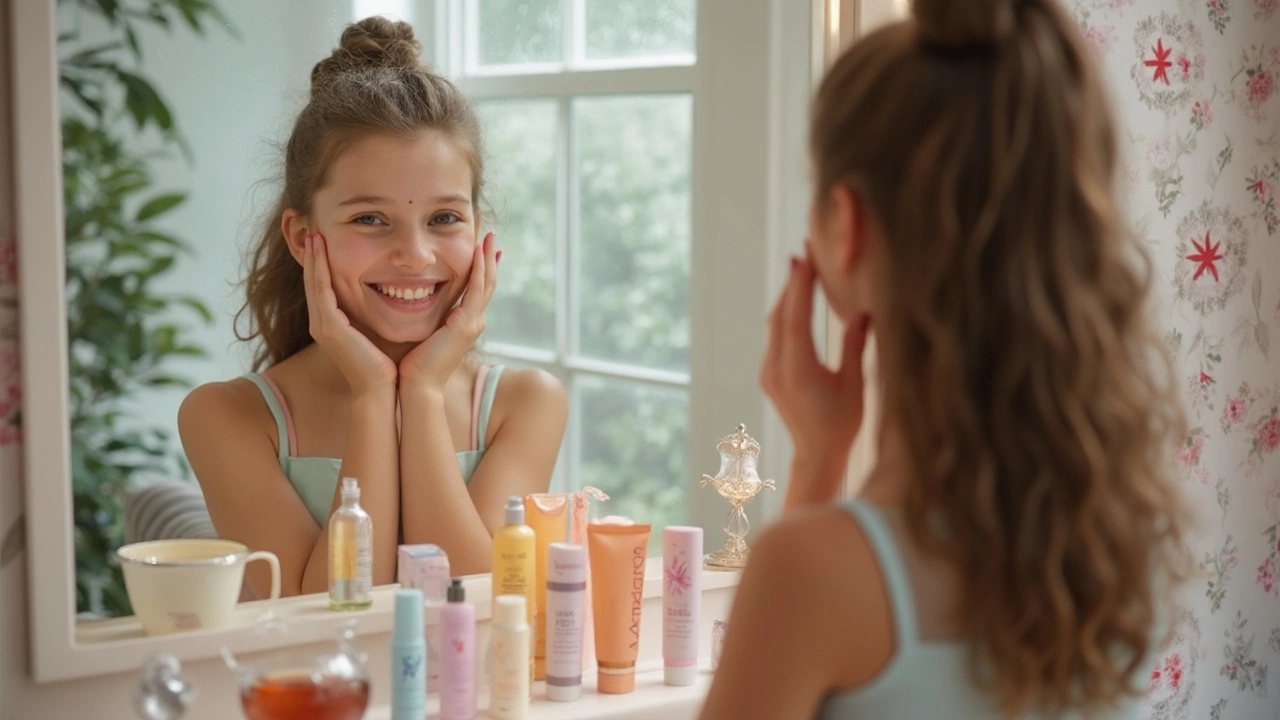If you’re staring at shelves packed with creams and serums, not sure where to even start, you’re definitely not alone. The good news? You really don’t need a 12-step routine to get healthy, glowing skin. Most people see real results from just three basic steps, as long as you do them right.
The first thing to understand is your own skin. Is it oily, dry, or somewhere in the middle? This matters way more than the brand you pick. But honestly, you don’t need fancy gadgets or apps—just notice if your skin feels tight, looks shiny, or breaks out. Simple observations work.
Starting simple will save you time, money, and drama. You’ll also avoid that classic new-skincare fail: slathering on a bunch of random stuff and ending up with red, irritated skin. Let’s cut through the hype and focus on what actually matters. Ready to make it easy? Let’s figure out what really works—and skip all the junk.
- How to Know Your Skin Type
- The Core Three: Cleanse, Moisturize, Protect
- Choosing Products That Actually Work
- Avoiding Common Beginner Mistakes
How to Know Your Skin Type
Before you grab any products, you need to know what you’re working with. Your skin care routine only works if it’s matched to your skin type. Here’s the deal: you don’t need a dermatologist visit or fancy tools for this step. Some small tests and careful observation tell you almost everything you need.
Most people’s skin falls into one of four types—normal, oily, dry, or combination. Here’s how to spot yours:
- Normal: Feels comfortable, has few blemishes, and isn’t super shiny or flaky.
- Oily: Looks shiny within a few hours after cleansing, and you’ll probably blot oil off your face by noon. Prone to clogged pores and breakouts, especially on the forehead, nose, or chin.
- Dry: Feels tight, rough, or itchy, possibly with flakiness. You might see dull spots, especially after washing.
- Combination: Oily in some places (usually the T-zone—forehead, nose, chin) and dry or normal on your cheeks. The most common type, believe it or not.
Not sure which fits? Try this easy test after washing your face:
- Wash your face gently with a mild cleanser and pat dry.
- Wait about an hour. Don’t put anything else on.
- After an hour, check your skin in a mirror and gently blot different areas with a tissue—forehead, nose, cheeks, and chin.
- Notice how your skin feels and looks. Is it shiny or tight anywhere? Where did the tissue pick up oil?
This method gives you a pretty accurate picture. A lot of people are surprised—they think they’re oily all over, when actually it’s just certain spots. Knowing this before you shop makes building your beginner skincare routine way less confusing.
| Skin Type | Main Signs | What to Avoid |
|---|---|---|
| Oily | Shiny, enlarged pores, frequent breakouts | Heavy creams, harsh scrubs |
| Dry | Tightness, flakiness, dull look | Foaming cleansers, alcohol-based toners |
| Combination | Oily T-zone, normal/dry cheeks | Single-product routines, skipping moisturizer |
| Normal | Balanced, few issues, soft texture | Over-exfoliating, strong actives |
Getting your skin type right saves money and frustration. Mismatched products are a top reason new routines flop. Focus on what your skin actually needs, not what’s trending online, and you’ll already be ahead of most newbies.
The Core Three: Cleanse, Moisturize, Protect
The core of any skin care routine is super straightforward: cleanse, moisturize, and protect. You don’t need to complicate things to get amazing results. Here’s how to nail each step from the start.
Cleansing comes first. This is all about getting rid of sweat, dirt, and leftover makeup. Most dermatologists recommend washing your face once in the morning and once before bed. For beginners, a gentle cleanser—no harsh scrubs or fancy acids—is usually enough. If your skin feels squeaky or tight, your cleanser is probably too strong.
Moisturizing is key for everyone, whether you have dry, oily, or combination skin. Moisturizers help lock in water and keep the skin barrier healthy. Look for labels that say “non-comedogenic” if you're worried about breakouts. Ingredients like glycerin and hyaluronic acid add moisture without making skin greasy. And a fun fact: people who use moisturizer daily are less likely to show early signs of aging, according to a huge 2022 consumer study.
Protection means sunscreen. This is the step most beginners skip, but it’s actually the most important for long-term skin health. UV rays hit your skin even on cloudy days or when you’re inside near windows. Go for at least SPF 30 and reapply if you’re outside for more than two hours. Applying sunscreen daily can slash your risk of new dark spots and wrinkles by nearly 40%, according to recent skin health research.
- Cleanse: Pick a gentle, pH-balanced face wash. Avoid anything that stings or foams like dish soap.
- Moisturize: Choose a cream or gel that matches your skin type. Apply right after cleansing for best results.
- Protect: Use a broad-spectrum sunscreen every morning, rain or shine.
If you want proof that these basics work, check out the stats:
| Step | What It Does | Best Practice |
|---|---|---|
| Cleanse | Removes oil, dirt, and makeup | Twice a day, gentle formula |
| Moisturize | Keeps skin barrier balanced | After cleansing, right formula for type |
| Protect | Blocks UV damage, prevents aging | SPF 30+, daily and often |
Stick to these steps and you’ll set yourself up for healthier, better-looking skin. No need for extra steps—just do these three every day, and you’re ahead of the game.

Choosing Products That Actually Work
Let’s keep it real—when you’re new and staring at a hundred options, it’s easy to buy what’s trending. Problem is, flashy packaging doesn’t mean results. Here’s what you actually need for a skin care routine that gets the job done.
- Cleanser: If you wear makeup or sunscreen (and you should), look for a gentle, non-stripping cleanser. Cream cleansers work great for dry skin. If you’re oily or breakout-prone, a gel or foaming cleanser with salicylic acid can help without making things worse.
- Moisturizer: No matter your skin type, you need to hydrate. Light, gel-based formulas fit oily skin. Creamier moisturizers suit dry skin best. Ingredients like hyaluronic acid are well-loved for locking in moisture and are safe for beginners.
- Sunscreen: This isn’t just for the beach. Daily SPF 30 (or higher) protects your skin from early wrinkles and spots. Dermatologists always say sunscreen is the best anti-aging product—seriously. Pick one labeled “broad spectrum” and apply it every day, rain or shine.
Don’t get distracted by fancy extras until you’re solid with the basics. Adding things like vitamin C serums or exfoliants helps later, but piling them on at the start usually causes more issues than benefits.
Labels matter, so check for the words “fragrance-free” or “non-comedogenic” if your skin is sensitive or acne-prone. And “for all skin types” doesn’t always mean it’ll work for you—watch how your skin actually reacts over a couple of weeks.
Check out this quick table of beginner skincare picks and their main benefits:
| Product | Key Ingredient | Main Benefit |
|---|---|---|
| Cetaphil Gentle Cleanser | Glycerin | Hydrates while cleansing |
| Neutrogena Hydro Boost Gel | Hyaluronic Acid | Lightweight hydration |
| La Roche-Posay Anthelios SPF 60 | Avobenzone | UVA/UVB protection |
Stick to one new product at a time so you can spot what actually helps or causes problems. If your skin gets red, itchy, or breaks out, back off and try something gentler. Give each new step at least two weeks before judging the results. Patience is your best friend here.
Avoiding Common Beginner Mistakes
When diving into a skin care routine for the first time, it’s easy to make some classic blunders. These mistakes don’t just waste money—they can irritate your skin, too. Let’s call out a few of the biggest ones so you don’t fall into these traps.
- Doing too much, too fast: Piling on extra products won’t get you clear skin overnight. In fact, studies from dermatology clinics show that about 30% of new users end up with breakouts or redness from starting too many products at once. Stick with the basics—cleanser, moisturizer, and sunscreen—before adding anything else.
- Skipping sunscreen: Even if you’re indoors most of the day, daily use of sunscreen is the #1 thing dermatologists agree protects your skin long-term. UV exposure is a main cause of wrinkles and spots, and windows don’t block all the rays. Look for a broad-spectrum SPF 30 or higher and use it every morning as the last step.
- Switching products constantly: Your skin needs time to adjust and show results. Jumping from one product to another every week just confuses your skin and makes it hard to tell what’s working. Get in the habit of sticking with something for at least three weeks before judging it.
- Using products not made for your skin type: If you have oily skin, thick and heavy creams can make things worse, while foamy cleansers may dry out already dry skin. Check the label, and when in doubt, start with formulas labeled “gentle” or “for all skin types.”
- Ignoring irritation: A little tingling is normal with some things, but stinging, burning, or lasting redness means something’s not right. Nothing in a beginner skincare routine should ever leave your skin sore or flaky. If it does, either cut down how often you use it or toss it entirely.
Want a quick reality check? Here’s what most beginners run into with their new routines:
| Common Mistake | Percentage of Beginners |
|---|---|
| Using too many products at once | 30% |
| Skipping sunscreen | 42% |
| Quitting before 3 weeks | 36% |
That’s a pretty clear sign—don’t overcomplicate things. Focus your beginner skincare around the main steps, listen to your skin, and always—and I mean always—wear sunscreen.

